As we all know, the great enemy in the war on terror is the roaming gangs of whales who maraud up and down coastlines, threatening our way of life. These cetaceous behemoths often loiter in the ocean depths in sleeper pods awaiting the signal to attack. Chaos and destruction invariably follow as suicide pod members beach themselves at random.
The adminstration have developed strategies for identifying and capturing these terrorist beasts, and detainees undergo comprehensive interrogation from highly skilled intelligence operatives.
Identifying the offensive species is a fundamental priority. To this end, sketch artists have prepared the following composite drawings to assist various agencies engaged in the tracking and defeat of these waterbound enemy combattants.





Intelligence gathering efforts equip our brave armed services with the knowledge required for covert situational deployment using specifically designed craft.
In accordance with standard operating procedures, mobilization of overwhelming troop numbers allows identified pod members to be separated from their sleeper units and arrested with a minimum of collateral damage.
On the advice of counsel, detainees are then moved to offshore facilities and their classification as enemy combattants enhances the intelligence gathering ability by indefinitely delaying any procedural legal intervention. This is to ensure that these criminals are unable to further disrupt the lives of peaceful, freedom loving people everywhere.
Whaling agents are briefed with extensive background material and are well placed to cut up the salient information received during questioning of the enemies.
Camp commanders are provided with the latest high-tech equipment that they employ in humane interrogation sessions with each inmate.

Of course these recalcitrant extremists are strongly resistant to regular questioning methods and a very few overenthusiastic guards have on occasion, (although with wholly legitimate and freedom promoting aims in mind) unfortunately injured some of the prisoners.
This information is being made public as part of the adminstration's determined efforts to keep all citizens fully informed and should in no way be viewed as a knee jerk response to the publication of alleged 'mistreatment' images by certain irresponsible sections of the media.
Counsel has again provided advice in this regard and from now on, any supposed indirect deleterious consequences to enemy combattants during interrogation who are held without charge in non-jurisdictional offshore facilities shall be referred to as 'research'. Whilst this may inadvertently afford prison staff protection from prosecution for abuse or maltreatment or assault or even murder of whales, a change in terminology actually reflects the ongoing intelligence accumulation and predominantly scientific nature of the operation.

With the implementation of these tactics, freedom loving people everywhere can demonstrate their opposition to the terrorist behaviour of murderous whales in the most overt way possible: by living a full and happy life.

A large number of anachronistic tactic manuals for killing identifying and trapping renegade terrorist whales during the Edo period (1603-1867) are available in scroll and book form in readily accessible thumbnail displays at the Kyushu University Museum.
[Inadvertently via the Armchair Aquarium]. Previously: 'Baleen Believer'.
Friday, June 23, 2006
The Whale Terrorists
Wednesday, June 21, 2006
Zoomorphic Calligraphy
"This new mode was not a matter of script metamorphosing into living forms which are also readable letters, but of using script to delineate such forms. Seldom had the flexibility of the Arabic alphabet been so tested.
This practice established itself only relatively late in Islamic art, when the taboos outlawing religious iconography had lost some of their power.
[Zoomorphic calligraphy] developed [..] in Ottoman Turkey, India and Qajar Iran [and] was known as early as 1458."
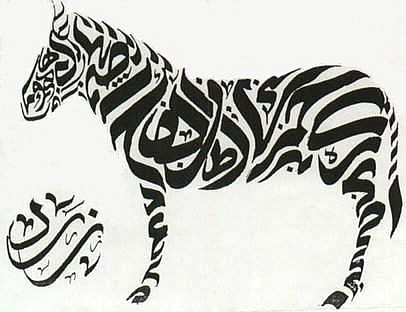




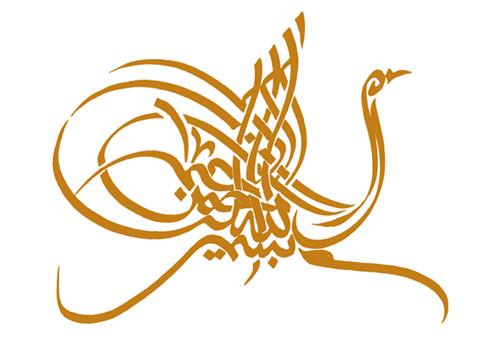

All the above zoomorphic (and anthropomorphic) works are © Hassan Musa from Sudan.
Most, but not all, of these images come from the Sudan Artists Gallery.


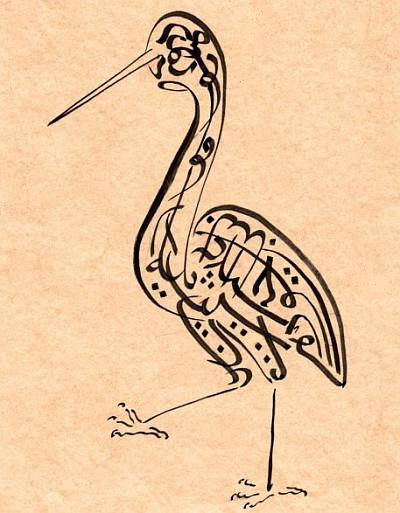



"Hafez (d. 1390) is Iran’s premier and most quoted lyric poet. His status in his own country, and his universal appeal, can be compared with that of Shakespeare in the English-speaking world. The painter and printmaker Jila Peacock has chosen ten love poems from Hafez and following the footsteps of the great Islamic calligraphers, has produced ten shape-poems that sit by her own translations from the Persian."
'Ten Poems from Hafez' by Jila Peacock includes a fascinating introduction -- and the best information online I could find about zoomorphic calligraphy -- by Robert Hillenbrand, Professor of Islamic Art at the University of Edinburgh.
'Ten Poems from Hafez' also just happens to be one of the display items in a current free exhibition at the British Museum 'Word into Art: Artists of the Modern Middle East' until September 3, 2006. {click the small book icon near the bottom of Jila Peacock's site to see the images}


17th century album leaf from Ottoman Turkey.
The inscription forming the peacock's tail reads:
"Beautiful as a houri, of angelic character, of auspicious omen, envy of the perfect ones, parrot of sweet tongue and sweet speech, peacock of the garden of … the lofty decree, sultan of the sultans of the world, fortunate and august, khaqan of the shahs, Darius of the time, Faridun of the age, hero of the world, [text reverses direction] champion of earth and time, sultans of the sultan of the family of cUthman ibn Sultan Ghazi Khan … may God extend the days of his [happiness] to the day of [judgment?]."
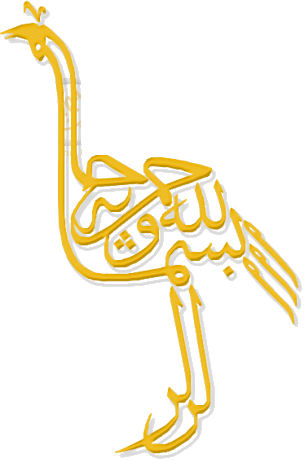

Surprisingly there doesn't appear to be any specific site or exhibition devoted solely to zoomorphic calligraphy so I went sifting with a clutch of search terms in english and arabic to find some images. If anyone knows of any other material, please post the links as a comment or email me.
Zoomorphic calligraphy is another one of those areas where I am far out of my depth and even using the array of well-polished BibiOdyssey mirrors I couldn't illuminate the subject to any worthy extent. The Hillenbrand article linked above is a good start {update: posted in full in the comments below for posterity}. I just love the art form.
- "Fine Kufic or nasta'liq in farsi Tugra Scroll measuring 118" x 9" with 13 Tugras or Zoomorphic Calligraphy drawings. Circa 1900 or earlier. Persian or possibly Urdu."
- Sakkal Design - calligraphy examples/links.
- The art of Turkish calligraphy.
- The wikipedia article on Islamic calligraphy is quite good and among the many links are some of the example illustrations above.
- Blog post on Turkish calligraphy.
- Related posts at BibliOdyssey: Arabic + calligraphy.
- UPDATE: read the comments below: I've pasted in the Hillenbrand article to ensure it is preserved.
- Books on Islamic calligraphy.
Tuesday, June 20, 2006
Butterflies and Beetles
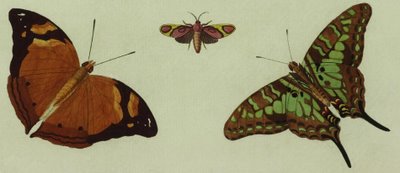



 Dutch amateur naturalist Pieter Cramer had an extensive natural history collection. He arranged for Gerrit Wartenaar Lambertz to prepare drawings of his specimens and also other lepidoptera collections in Holland.
Dutch amateur naturalist Pieter Cramer had an extensive natural history collection. He arranged for Gerrit Wartenaar Lambertz to prepare drawings of his specimens and also other lepidoptera collections in Holland.Cramer wrote descriptions of each species for a serial publication released between 1779 and 1782. This was the first book on exotic lepidoptera to include the Linnaean binomial nomenclature system and therefore remains an important historical text in the field of entomology. Cramer died in 1779 and the work was completed by Caspar Stoll.
'De Uitlandsche Kapellen' {'Papillons Exotique'} is online among the Monographs Collection at Herzogin Anna Amalia Bibliothek - at least, all the original plates (must be 200 or more) are available sans text. Click on 'Vorschau' to get the page thumbnails (a large load). The images are much larger when saved than they appear on the screen. [nb. there is another volume]
Update: another version at the University of Heidelberg.



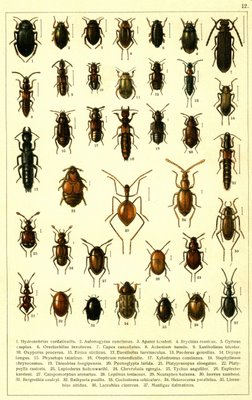
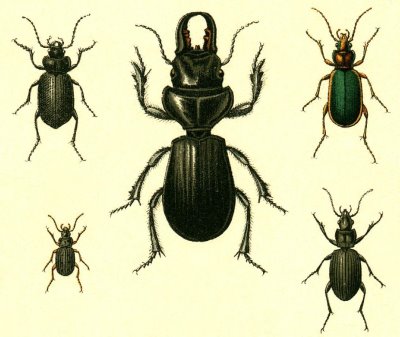
To commemorate the centenary since the publication of GG Jacobson's 'The Beetles of Russia and Western Europe' last year, the Coleoptera Department at the St Petersurg Russian Academy of Science posted all 83 colour plates from the book online [direct to thumbnail page] They have enormous images available for download if you so desire. Although I've only had a cursory look, the whole Coleoptera site (in english) is exemplary. [Parent site]
Sunday, June 18, 2006
Token Untitled Post
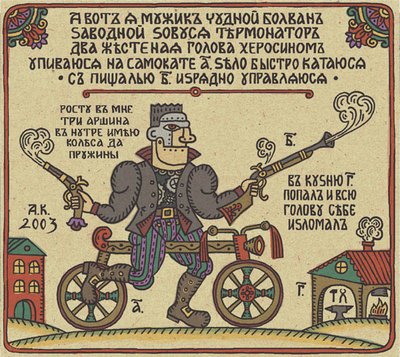 Modern movies as folk prints - woodcut images in the Russian Lubok folk art tradition. Requires more in the way of interpretation than translation. [via MonkeyFilter]
Modern movies as folk prints - woodcut images in the Russian Lubok folk art tradition. Requires more in the way of interpretation than translation. [via MonkeyFilter]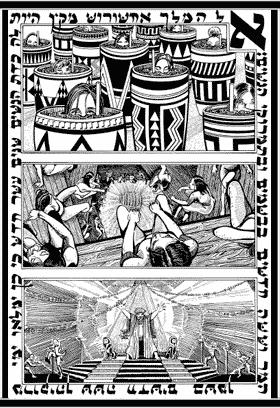 Megillat Esther : The Book of Esther from the Tanakh (Jewish Bible)
Megillat Esther : The Book of Esther from the Tanakh (Jewish Bible)and Old Testament refashioned as a graphic novel. [via Menachem Mendel]
Somewhere in the University of Bielefeld.
 From the 2nd edition of 'New Zealand Birds and How to Identify Them'
From the 2nd edition of 'New Zealand Birds and How to Identify Them'by Perrine Moncrieff (first published 1925) at Glyph Jockey.
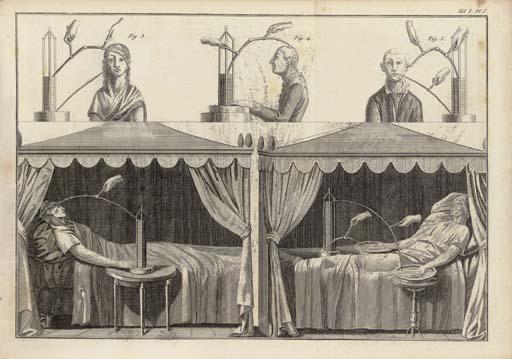 Although they don't have large images, the Christies Auction site is a veritable smorgasbord for rare printed material. I seem to recall the above image, snagged at random, has something to do with galvanometry or human electricity or the somesuch. [Of particular note: 'The History of the Book: The Cornelius J. Hauck Collection' - auction next week. Drool.]
Although they don't have large images, the Christies Auction site is a veritable smorgasbord for rare printed material. I seem to recall the above image, snagged at random, has something to do with galvanometry or human electricity or the somesuch. [Of particular note: 'The History of the Book: The Cornelius J. Hauck Collection' - auction next week. Drool.] "Indonesian Batak Pustaha - Detail from nineteenth century magic
"Indonesian Batak Pustaha - Detail from nineteenth century magicbook, written on bark from the alim tree and used by medicine-men
in performing ceremonies. Folded in concertina fashion."
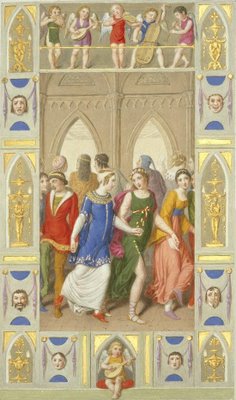
 The above 2 images are taken from an 1819 edition of
The above 2 images are taken from an 1819 edition of'Giulietta e Romeo' by Luigi Da Porto
(originally published sometime before 1529 - this is the book
that Shakespeare's Romeo and Juliet is based on)
 'Lud Hurdibras, Bladud and King Leir (Lear)' from:
'Lud Hurdibras, Bladud and King Leir (Lear)' from:'Genealogy and Race of all the Kings of England' 1562 by Giles Godet.
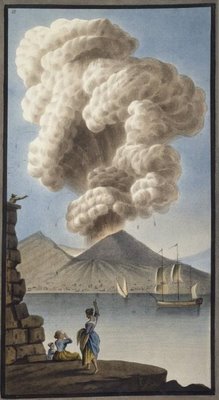 This painting is found in Sir William Hamilton's 'Campi Phlegraei, Observation on the volcanos of the two Sicilies As they have been communicated to the Royal Society of London' 1779. The image is one of 5 supplementary plates Hamilton included as an appendix to his vulcanology book following the eruption of Mount Vesuvius in Naples in 1779. More here, here and here.
This painting is found in Sir William Hamilton's 'Campi Phlegraei, Observation on the volcanos of the two Sicilies As they have been communicated to the Royal Society of London' 1779. The image is one of 5 supplementary plates Hamilton included as an appendix to his vulcanology book following the eruption of Mount Vesuvius in Naples in 1779. More here, here and here. An original pen/ink drawing -- 'Rocking Stones' --
An original pen/ink drawing -- 'Rocking Stones' --from 'Antiquarian Notes' 1789 by Dorothy Richardson.
It is a depiction of Logan Stones in Cornwall.
All the images from the Claxton Printers device onwards come from the excellent Rylands Collection at the University of Manchester. I've posted some alchemy images previously but there are more than 2,500 rare book images available. The bad news is that you must install the Insight™ Browser (not so bad). All of the above Rylands Collection images are made from spliced screen captures. They have an amazing and eclectic set of works - one of the best online UK repositories - and I still haven't been through them all.
=========================================
For those who read this site via an RSS feed, the BibliOdyssey sidebar is guaranteed to contain high fibre, low cholesterol digital comfort food:
::wood s lot::, Giornale Nuovo, Carolina Vigna-Marú, i like, RaShOmoN, Spiderblog, Blog With a View, Earmarks, boynton, Plep, Agence Eureka, Early Modern Notes, andreaxmas, Modern Mechanix, dirtybeloved, Bibi's Box, Carnet de Zénon, neurasthenia, Languagehat, Illustration Art, blanketfort, The Maproom, Coudal, \\Ursi//, Pruned, Philobiblon Book Arts, Lines and Colors, BookLust, things magazine, the nonist, Jaf Project, Incoming Signals, eyebeamR, Points of Departure, Drawn!, Eastern Blot, Spy's Spice, Sarsaparilla, Netlex News, ~Tiny Bubbles~, Psychick Blah, The Stingy Scholar, Malanda, Sarsaparilla, Philobiblon (History), Ramage, gmtPlus9(-15) - arranged in order of 'dart affinity'. Pants are optional.






